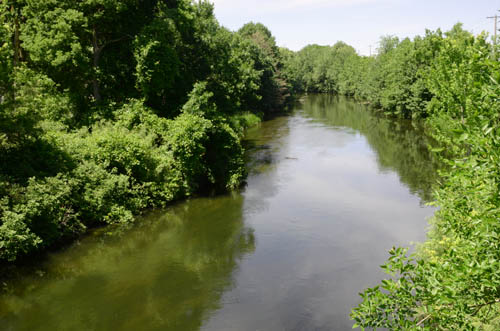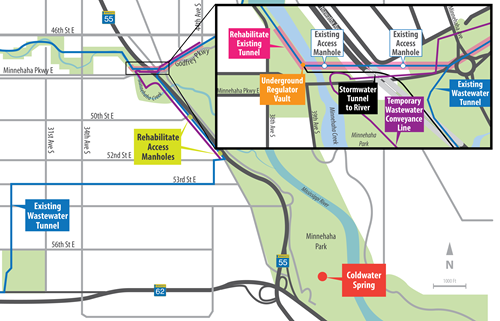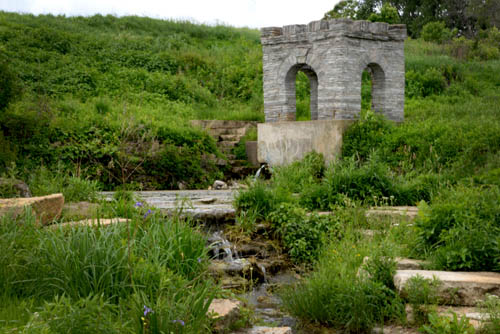Minnehaha Creek is a 22-mile urban amenity and outdoor adventure. Originating on the eastern end of Lake Minnetonka, the creek meanders through the cities of Minnetonka, Hopkins, St. Louis Park, Edina and Minneapolis, trips down a waterfall and spills into the Mississippi River.
 It’s a haven for canoers and kayakers and those who like to walk, pedal, ski or fish along its idyllic shores or picnic near the stunning Minnehaha Falls.
It’s a haven for canoers and kayakers and those who like to walk, pedal, ski or fish along its idyllic shores or picnic near the stunning Minnehaha Falls.
Certainly on no one’s mind in this natural sanctuary is the vast system of underground sanitary sewers at work to protect public health and the environment. The system carries wastewater from homes and businesses to Metropolitan Council wastewater treatment plants.
Beneath the creek, near Hiawatha Avenue and the METRO Blue Line, is a large, aging sewer tunnel. Built in 1935, the tunnel is in serious need of repair.
“The regional wastewater sewers are typically ‘out of sight and out of mind,’” said Jeannine Clancy, an assistant general manager in the Metropolitan Council’s Environmental Services Division (MCES).
“But the region’s investment in wastewater collection and treatment facilities needs to be maintained,” she said. “The infrastructure that protects public health and the environment requires an ongoing schedule of rehabilitation and improvement.”
Clancy says planned construction work at the Minnehaha Park area will result in some inconveniences in terms of noise, traffic, detours, and temporary above-ground wastewater conveyance pipes in the vicinity. But the time has come for improvements that reduce the risk of the tunnel’s failure.
Tunnel will be lined, not replaced, to minimize disruption
Metropolitan Council inspections show the tunnel in that location is corroded and damaged after its 80-plus years of service.
 To ensure the pipe’s reliability and structural integrity, the Council is proposing to rehabilitate about 1,000 feet of the sewer tunnel in and near Minnehaha Park, starting just west of the creek and extending across Hiawatha Avenue to the roundabout on Minnehaha Avenue.
To ensure the pipe’s reliability and structural integrity, the Council is proposing to rehabilitate about 1,000 feet of the sewer tunnel in and near Minnehaha Park, starting just west of the creek and extending across Hiawatha Avenue to the roundabout on Minnehaha Avenue.
The $31 million construction project is scheduled to begin in 2019, take about two years, and will occur on the north side of East Minnehaha Parkway. Rather than replace the tunnel, however, crews will install a liner inside the existing sewer, fusing together three-foot-long segments at a time.
In terms of size and depth, the tunnel measures about five feet by four feet and crosses 20 feet under the creek. East of the creek, the tunnel is three feet wide by six feet deep and drops to a depth of 74 feet.
“The depth of the tunnel in some places and limited access to other parts of the tunnel make this a more lengthy and complicated project,” said Scott Dentz, interceptor engineering design manager at MCES. “Once complete, however, we expect it’ll be in good shape for at least another 50 years.”
Plan modified to ensure protection of Coldwater Spring
If this project sounds familiar, it’s because it has been in the works for some time.
 Following extensive study, the Council modified an earlier plan that proposed constructing a new tunnel under the creek. The current proposal opts to rehabilitate the existing tunnel, which addresses local concerns about protecting groundwater flows to Coldwater Spring, about 1.5 miles south of the sewer improvement site.
Following extensive study, the Council modified an earlier plan that proposed constructing a new tunnel under the creek. The current proposal opts to rehabilitate the existing tunnel, which addresses local concerns about protecting groundwater flows to Coldwater Spring, about 1.5 miles south of the sewer improvement site.
“The Council’s current plan to line, rather than replace the tunnel deep underground, puts precautions in place to protect Coldwater Spring and avoid disruption in groundwater flow to the spring,” said John Anfinson, superintendent of the Mississippi National River and Recreation Area, a unit of the National Park Service (NPS).
The park service oversees the spring as part of its Mississippi National River and Recreation Area and monitors groundwater flow at the spring. Continued flow monitoring will look for any construction-related impacts. While the Council agrees monitoring is important, it believes its redesigned approach to the project will avoid impacts to the spring.
Coldwater Spring is considered a significant cultural, sacred, and historic resource. Anfinson agrees that the sewer project will accomplish two goals: 1) maintain groundwater flow to the spring, 2) prevent the aging sewer pipe to the north from failing.
“Doing nothing isn’t an option,” he said. “It would be disastrous if the aging sewer tunnel ruptures and sewage leaked into the groundwater system. The rehabilitation project that’s proposed is essential.”
Construction to start in 2019, end in 2021
The Council held a public meeting in April and public hearing and public comment period in May on proposed construction, in addition to meetings with local officials, neighborhood groups, the Native American community and environmental advocacy groups.
Following Council adoption of the sewer rehabilitation project plan in June and Minnesota Pollution Control Agency action later this year, construction is expected to begin in April 2019 and end in late 2021.
To pay for investments in the regional wastewater collection and treatment system, the Council secures Minnesota Public Facilities Authority loans and/or issues bonds that are repaid with wastewater user fees that MCES collects from across the region.
The regional system collects and treats about 250 million gallons of wastewater a day from 109 metro-area communities and 2.6 million residents. Wastewater is conveyed to the regional system of pipes and plants via about 5,000 miles of sewers that local communities own and maintain.
Council officials estimate the value of the region’s investment in eight treatment plants, 600 miles of interceptor pipe and metering and lift stations to convey wastewater flow at $7 billion.
More information
More information and project updates about the Minneshaha Park Area Regional Sewer Improvements Project.